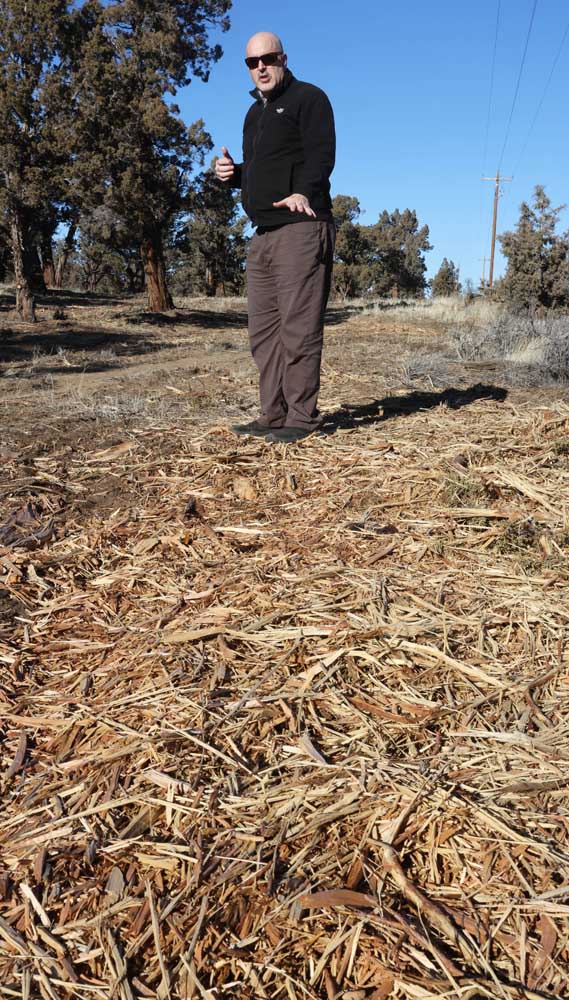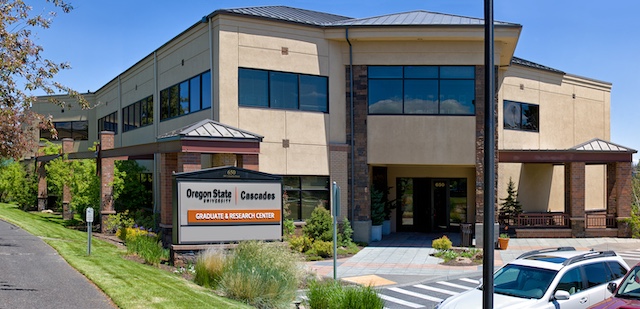Deschutes County Firewise helps harden communities
Published 5:45 am Saturday, January 18, 2025

- Kevin Moriarty, Deschutes County Forester points out wood chips from a mastication project adjacent to a residential development off of McGrath Road.
Each summer and into fall, wildfire burns unnervingly close to communities in Central Oregon. The response from fire crews is usually swift and strategic. The Forest Service and its partner agencies put boots on the ground to battle fires up close while aerial support bombards the flames with water or fire retardant from above.
These actions were evident last summer when the Darlene 3 Fire burned on La Pine’s eastern edge. Then in September, the Little Lava Fire caused evacuations in parts of Sunriver. Between these incidents, the Milemarker 132 Fire on Bend’s northern side had residents near Cooley Road worried about fire entering their neighborhood.
Trending
Any of these incidents, coupled with a strong wind event, could have been catastrophic.
While we cannot stop the wind or prevent all fires from starting, Central Oregon does have a robust defensive plan in place, quietly working year-round. Home hardening, forest thinning, prescribed burns and community brush-clearing events are part of Central Oregon’s fire protection fabric.
Firewise communities
Deschutes County is also home to nearly 80 active Firewise communities. Another 20 communities are located in Jefferson and Crook counties.
These communities are one way that local leaders and fire officials can engage with residents and homeowners to create neighborhoods that can withstand a wildfire that threatens homes and urban areas. They are also opportunities for ordinary citizens to become experts on wildfire safety and resilience.
Trending
Read More: Wildfire evacuation in Central Oregon: What to know, how to prepare
“The sense of community and ability to work together and identify mitigation measures that benefit the group as a whole is the greatest advantage for attaining Firewise USA recognition,” said Christie Shaw, national fire plan coordinator with the Oregon Department of Forestry.
Oregon Department of Forestry administers the Firewise program in Oregon along with cooperative partners such as Oregon State Fire Marshal, local fire districts, non-profit organizations and the landowners themselves. The program is co-sponsored by the USDA Forest Service and the National Association of State Foresters.
Active sites, 78 and counting
Deschutes County has 78 active sites and is ranked as the fifth highest of counties across the nation. The four counties ranked higher are all in California. Jackson County (Oregon) is sixth with 75 sites.
Deschutes County sites recorded an investment of $3.85 million of mitigation, outreach, home hardening, and education activities on active sites in 2024, said Shaw. This includes volunteer hours converted to dollars and money paid to contractors for work. The lifetime investment for currently active sites in the county is $19.7 million. Active sites in the county removed 29,000 cubic yards of fuel/material within the Firewise USA sites last year.
Only eight residences need to participate to maintain Firewise status and each of them only needs to invest around $30 a year in doing some work to show their commitment.
“The Firewise program has a low barrier of entry in order to try to attract and keep more people involved,” said Eric Metzger, a community wildfire forester with the Oregon Department of Forestry.
“It is a lot more about building community than it is about ensuring comprehensive physical safety. Each homeowner still needs to take responsibility for their own home itself and immediate defensible space,” he said.
Community opportunities
Firewise communities can do a variety of things to protect themselves. Opportunities include residential fuels removal, roadside information sessions, home vulnerability assessments and even kid-focused education sessions.
But not all Firewise communities operate with the same intensity, said Metzger. Some are very active, investing thousands of dollars each year in everything from pine needle clean-up days to brush clearance and tree removal projects, involving dozens of residences.
“Some others barely clear the minimum bar,” said Metzger. “We are still super happy to have them involved in the program, make ourselves available to give them advice and perform site visits whenever we can with the personnel that we have.”
Not a magic bullet
Kevin Moriarty, the Deschutes County forester, says Firewise is not a magic bullet that can save a community from extreme fire.
“If you’re getting a fire with 50 plus mile an hour winds, you’re just not going to stop that fire. There’s just not much you can do,” said Moriarty. “You’re really just holding back and then seeing what the aftermath is when those winds die down. That’s hopefully where the fuel breaks, the defensible space, the home hardening might reduce some of (the impact of) that conflagration.”
Because they can help reduce fire impacts or prevent them altogehter he encourages other communities to participate.
“It’s better than not being a Firewise community because at least you’ve created an action plan,” he said. “A lot of the homeowners are working towards that action plan,” he said.
To learn more about Firewise communities, Deschutes County has a Firewise story map with details of the program. It can be viewed at: https://bendbulletin.us/firewise
Protecting your home
What can you do to protect your community?
Kevin Moriarty, Deschutes County Forester, offers the following advice when considering defensible space around your home:
• Look carefully at the first five feet outside of your home. Large brush or trees that are right up to your home make it highly susceptible to burning. Limit this vegetation and any other combustible materials.
• Consider any kind of home hardening (roof or siding improvements) that may be needed, especially for older homes.
• Replace quarter-inch screens that cover vents. These should be changed to one-eighth-inch screen vents to prevent embers from getting into vents.








